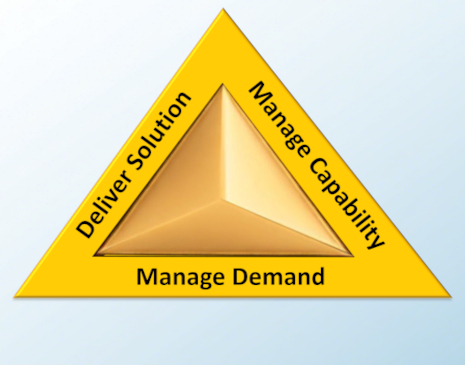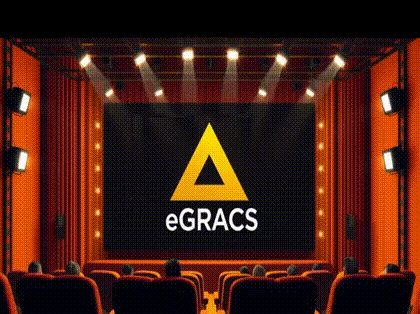The eGRACS Golden Triangle is not just an abstract concept — it’s a practical design that can be applied immediately to your ICT governance framework. In this page, we’ll take a deep dive into how this visual model helps you structure your governance, risk, and compliance initiatives, and how it drives clarity and simplicity from the boardroom to the data center.
 We all know that governance, risk, and compliance efforts can often feel like you're pushing a boulder uphill. Every new framework, regulation, and audit trail adds weight to the task. But by using the eGRACS Golden Triangle design, you can create a roadmap that aligns these efforts with organizational goals. It’s the key to transforming complex requirements into a seamless workflow that moves from the top-down to the bottom-up.
We all know that governance, risk, and compliance efforts can often feel like you're pushing a boulder uphill. Every new framework, regulation, and audit trail adds weight to the task. But by using the eGRACS Golden Triangle design, you can create a roadmap that aligns these efforts with organizational goals. It’s the key to transforming complex requirements into a seamless workflow that moves from the top-down to the bottom-up.
The Core of the eGRACS Golden Triangle:
Unified Controls
 The core of the eGRACS Golden Triangle consists of the three pivotal controls that shape the strategic direction of your ICT governance framework. These are: Manage Demand, Deliver Solution, and Manage Capability. Think of them as the foundation upon which everything else is built — without these three, your governance structure would crumble.
The core of the eGRACS Golden Triangle consists of the three pivotal controls that shape the strategic direction of your ICT governance framework. These are: Manage Demand, Deliver Solution, and Manage Capability. Think of them as the foundation upon which everything else is built — without these three, your governance structure would crumble.
Each of these pillars is designed to ensure your ICT systems are aligned with business goals, future-proofed for long-term scalability, and operationally resilient. The eGRACS Golden Triangle’s tiered design ensures that every control within your organization’s ICT management system works harmoniously to drive strategic clarity and reduce inefficiencies. This framework allows you to control what matters most: security, compliance, and business continuity.
“The eGRACS Framework has not only simplified our approach to governance, but has also made us more agile in responding to new compliance requirements. The eGRACS Golden Triangle design is truly revolutionary.”
The Power of the Fractal Structure
The brilliance of the eGRACS Golden Triangle design is that it is inherently fractal. This means that the design scales effortlessly from the strategic level all the way down to the tactical level. The three initial controls at the core level don’t just apply to high-level strategy. They break down into more granular controls as you move through the four tiers of the framework, allowing for a smooth and logical progression from vision to execution.
 For example, the Manage Demand control doesn’t just sit in the Core Tier. It branches out into specific strategic components, such as Manage Strategy, Manage Architecture, and Manage Assurance. As you move downward through the tiers, these controls become more operationally focused, ensuring that everything from high-level planning to daily execution is aligned with the organization’s goals. Each control set feeds into the next, creating a feedback loop of continuous improvement and alignment.
For example, the Manage Demand control doesn’t just sit in the Core Tier. It branches out into specific strategic components, such as Manage Strategy, Manage Architecture, and Manage Assurance. As you move downward through the tiers, these controls become more operationally focused, ensuring that everything from high-level planning to daily execution is aligned with the organization’s goals. Each control set feeds into the next, creating a feedback loop of continuous improvement and alignment.
Putting It All Together
To fully unlock the power of the eGRACS Golden Triangle, you need to implement it across all levels of your organization. Whether you’re a CIO overseeing strategic governance or an IT operations manager executing tactical tasks, the eGRACS Golden Triangle provides a clear path for aligning every piece of the puzzle.
 Let’s imagine this for a second: You’re managing a global enterprise, and you need to harmonize compliance with NIST, ISO, PCI-DSS, and GDPR across multiple regions. It sounds like a nightmare, right? Now, imagine the eGRACS Golden Triangle as a roadmap that guides you through this labyrinth, ensuring that every new regulation fits into the larger governance structure. The simplicity and clarity that the eGRACS Golden Triangle brings to this process is the difference between chaos and control.
Let’s imagine this for a second: You’re managing a global enterprise, and you need to harmonize compliance with NIST, ISO, PCI-DSS, and GDPR across multiple regions. It sounds like a nightmare, right? Now, imagine the eGRACS Golden Triangle as a roadmap that guides you through this labyrinth, ensuring that every new regulation fits into the larger governance structure. The simplicity and clarity that the eGRACS Golden Triangle brings to this process is the difference between chaos and control.
The end result is a cohesive and adaptive framework that allows you to focus on what matters: securing your organization’s data, meeting compliance obligations, and ensuring your ICT systems are scalable and future-ready. And all of this starts with the eGRACS Golden Triangle design.
🔙 The Golden Triangle of Governance 🔜 Implementing the Framework


